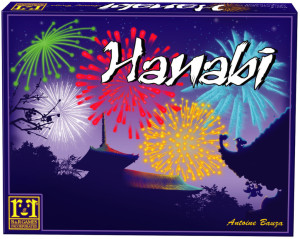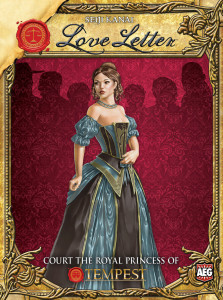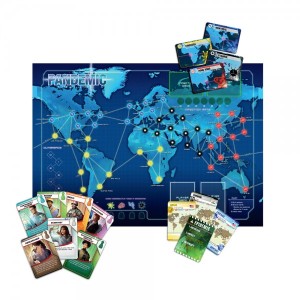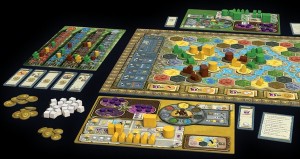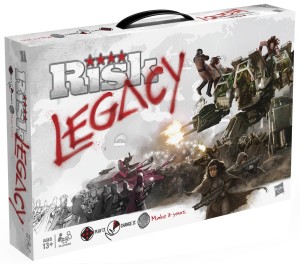It’s been a while since my last boardgames post and I’ve played a number of other games in the last two years. Many of these games aren’t exactly new, but they’re new to me.
Some new favorites:
Hanabi
This is a cooperative card game with a unique twist. You don’t see your own cards until you play them. There are five colors of cards (plus a bonus rainbow color for advanced players) with numbers one through five. The goal is to play all five colors in order from one to five. Each player gets a turn and they have one of three actions. The player may give a clue to another player. The player may play a card from their hand. The player may discard a card. Players win by playing all twenty-five cards or by getting through the deck without four misplays. There are some limitations on the kinds of clues and the number of clues, but it’s a very elegant set of rules.
The game is deceptively simple, and there are layers of strategy in which clues a person provides, who receives clues and even how long it has been since a person has received a clue.
This a fascinating game, and I highly, highly recommend it.
Love Letter
Another fairly quick card game, but not cooperative. In this game there are eight types of cards ranging from a lowly guard all the way to the princess. The theme is that the player is trying to send a letter to the princess, and the person that sends her letter as close to the princess as possible wins the round. The players start with one card in their hand and then draw a single new card each turn. Each type of card has a unique effect, and the player must always play one card. There’s a good bit of interaction between players, and the rounds move very quickly. My girls love the game, though I’m not quite as crazy about it. The randomness of the card draws has just as much (or more) outcome on the game as the individual player’s decisions. This makes it fun for newer (or younger) players, but it gets old for those with more experience.
It’s fun, but simple, and well worth consideration.
Pandemic
Pandemic is an older game, but my group has only recently started playing it. We immediately loved the theme of CDC researchers trying to stop the world’s destruction by multiple viruses. The game requires good communication and good coordination in order to succeed, but even then there are no guarantees. Some of the role cards are significantly stronger than others, so if you’d like an easier path into the game, consider selecting some of the more powerful roles.
I love this game. The theme, the teamwork, the nailbiting tension as the draw deck dwindles and too many infections remain on the board. It’s a blast and a must-play.
Terra Mystica
In Terra Mystica you are playing as one of 14 different factions. The victory conditions are the same for every faction, but there are some differences in how they get there.
The basic goal of the game is to terraform land, build buildings, lead a cult, and score victory points. The game happens over the course of six (or maybe it’s seven, I don’t remember exactly) rounds. You get points along the way for leading some faction of the cult (Wind, Water, Earth, Fire) or building certain buildings.
The buildings themselves are pretty amazing. You have the settlement, recognizable from Settlers of Catan. It upgrades into the “trading post,” recognizable as the city from Settlers of Catan. The trading post upgrades to a Stronghold, recognizable as a squarish wooden thing, not from Settlers of Catan. Or if you’re feeling cultish, the trading post instead upgrades to a temple, recognizable as a round wooden thing that could belong to any other game ever. And finally the temple upgrades to a more expensive temple, not substantially different than a regular temple, called a sanctuary.
The real clever bit here is that your buildings are all on a little mat in front of you, and much like in Eclipse, when you place a building on the board, you then get paid the resources that the building was previously covering on your mat. Your settlements provide workers. Your trading posts provide money and “power.” Your strongholds provide something unique for each faction. Your temples and sanctuaries provide priests each turn, but also each one you build allows you to a gain a favor, and the favor itself provides various things including one time perks and recurring resources. The real key here is that you have to expand territory to put out new settlements, and those settlements provide additional workers, but when you upgrade the settlements, you put them back on your little mat, and you lose the worker income. So the game becomes a balancing act between going horizontal into more territory or vertical into better buildings.
There are four currencies in the game. One is money. It’s just… money. But money can’t buy you love, and neither can it buy you buildings unless someone actually builds them. So money gets used with your workers from your settlements to upgrade your buildings. Once you build temples, you get priests. They are used for things like building a navy (because buggery?) or incurring favor with the cults. Along the way, various things give you “power” and this is the most interesting currency, at least from a “I haven’t see anything work like this before” perspective.
Power is a finite resource on your playing mat, something like 14 little purple chips. These chips live in a set of three connected circles cleverly numbered 1, 2, and 3. They start in some combination of circles 1 and 2. The gimmick is that to spend them (which lets you do things and also moves the chips back to circle 1), you need chips in circle 3. And you can only move chips from 2 to 3 if all the chips are gone from circle 1. You can use power to gain extra money, extra priests, extra workers, bridges (recognizable as the roads from Settlers of Catan) that allow you to link buildings across rivers, and a few other things that don’t spring to mind. Once you get an engine going to bring in resources, power gives you a good bit of flexibility.
At the end of the game you score points for your position on each of the four cultist tracks. You also score for the total size (horizontal; it ignores vertical) of the linked buildings in your empire. And I definitely missed that the scoring ignored upgrades the first time I played, so that hurt. Ultimately, it’s a very clever, very fun game that combines the best bits of several other games, adds some of its own and calls it a day.
Risk: Legacy
This is not the Risk of my childhood. Yes, there’s still some dice rolling, and yes, Australia is still really strong, but there are so many changes that game only bears a passing resemblance to its namesake.
The biggest, most unique aspect of the game is that you the player will permanently alter the game every time you play it. At the very beginning of the game the players start by customizing their starting factions. Each faction has a sticker sheet with some abilities on it, and you only use part of those stickers. Once they are put on the faction’s card, they are permanent, and the others are thrown in the trash forever and ever amen. This is a theme that repeats itself through out the game. Events happen. Players respond. The game forever changes.
The second amazing aspect of the game are the “surprise” bins. The box ships with a number of sealed compartments. You are only supposed to open those compartments when the events listed on the compartment occur. This can be something like putting thirty armies on the board or using three nuclear missiles in a single combat or creating a special city. The boxes contain new cards to add to the game, new rules to put into the new rule book and all manner of wondrous and amazing things.
One of the single best moments I’ve had in any board game was when one of my regular gaming buddies and I got into a fight over a third buddy’s capital. The fight triggered an event, and it permanently modified that space on the board. It. Was. Glorious.
Unlike the Risk of yore, the game finishes when the first player acquires four tokens. At the beginning of the game (as in when you first start playing it), each player starts with one of these tokens, so victory can occur by capturing only three enemy capitals. No needs to conquer the whole world; only their nearest neighbors.
The game is intended to played fifteen times before the board stops changing. It’s been a blast getting to fifteen, and while there’s no reason to stop, I’m more likely to buy a new copy of it and start over from scratch. I really enjoy Risk: Legacy, and if you’re into wargames, you should take a look at it.
